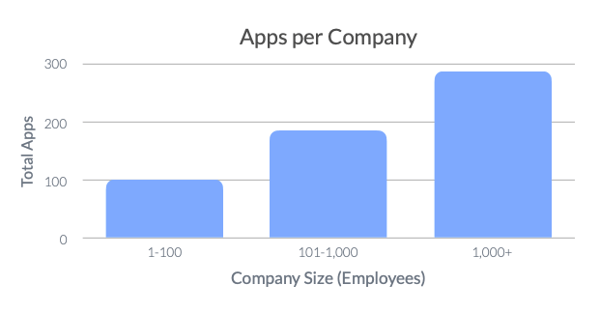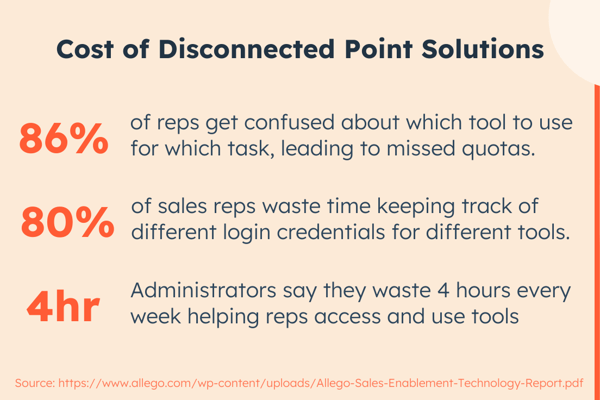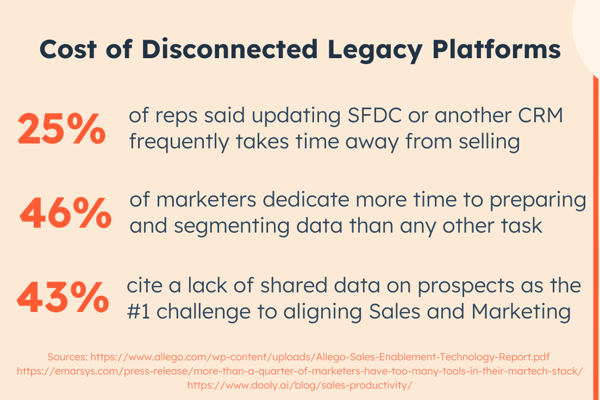.jpg)
CRM integration: the hidden costs of no single source of truth
Disconnected platforms cost more than we think dear readers. This is caused by 2 main reasons:
- Too many "pointy" solutions.
- Legacy disconnected platforms.
Too many pointed solutions
While point solutions can sometimes provide you with specific functionality for a single service, in-depth functionality for a specific channel, and the ability to respond quickly to your one-time needs, it's important to think about your technology investment more holistically.
Chart 1 👇, shows that companies are using a lot of SaaS applications.
Chart 1: Far too many applications are used

Blissfully. Saas Trend Report 2020: SaaS Apps Reign Supreme Across Departments, but Waste is Growing.
If you don't, your company will likely experience unexpected hidden costs, disparate data and lower user adoption. In fact, in a survey of 1,700 software buyers, it was found that the more advanced solutions are used, the higher the total cost of ownership.
Chart 2 shows the progression of the total cost of ownership very well, based on the number of point solutions used 👇.
Chart 2: Progression of the total cost of ownership
This cost is caused primarily by the increased costs of personnel using multiple tools. Figure 1 shows some of these "hidden" costs 👇.
Figure 1: The hidden costs of disconnected solutions
And psychologists have found that switching gears and connecting to disparate tools can eat up as much as 40% of an employee's productive time. Add to that the fact that the members of the marketing department use on average more than 10 tools, and these costs add up quickly.
Disconnected legacy platforms
The other common approach to front office software is to choose a legacy platform that has been built through the acquisition of cutting edge solutions. While this approach may seem like a better investment, there is more to it than the obvious. Digging a little deeper, Figure 2 shows some of these "hidden" costs 👇.
Figure 2: Cost of disconnected legacy platforms

A side note for those who wonder what the acronym SFDC stands for: it refers to the CRM "Salesforce dot com".
Each application or integration with a legacy platform is built on different programming languages, making it more complex, time-consuming and expensive to implement. Disparate user interfaces lead to lower user adoption, significant context switching, and disconnected data. As a bonus, the requirements for development efforts are costly.
So, in a survey of 1,700 software buyers, it was found that when your CRM tools are all integrated on a single platform, you get stronger connections between your data (a single source of truth) and your systems (see Chart 3 👇 ), and a better return on your technology investments (see Chart 4 👇 👇 ).
Chart 3: Level of CRM integrations relationship to data connectedness
Chart 4: Level of CRM integration relationship to return on investment (ROI)
In a nutshell
It is important to ask the right questions when choosing a CRM. Many companies, with or without a CRM, need to ensure that they are leveraging the power of an integrated CRM platform in order to:
- get the highest possible return on investment;
- increase adoption by sales, marketing, customer experience teams, etc;
- Reduce implementation and long-term maintenance costs;
- Improve customer and lead experience;
- Take advantage of a single source of truth, a wealth of data that breaks down the silos of sales, marketing, customer experience and customer service departments.
To go further, calculate the ROI of your CRM use, are you really profitable?




Comment this article